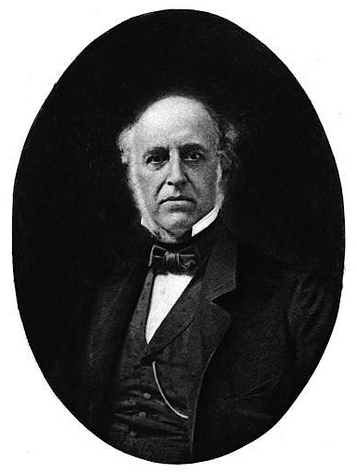 Thomas Bulfinch in 1896
Thomas Bulfinch in 1896
Thomas Bulfinch III (1796-1867) was part of a family with generations of influence at King’s Chapel. Charles and Grizzell Apthorp, Bulfinch’s great-grandparents, were a colonial power couple who owned pews and a tomb within the church as well as extensive property and business holdings in Boston and beyond. His grandfather, Thomas Bulfinch II, was a notable physician involved in early smallpox inoculation efforts in Boston and was instrumental in bringing James Freeman to King’s Chapel to lead the church through the turmoil caused by the American Revolution. Susan Bulfinch, his grandmother, was a strong, family-oriented woman whose abundance of letters (also featured in this month’s exhibit) allow modern readers insight into the family’s life. His parents were Hannah Apthorp Bulfinch and Charles Bulfinch, the architect who designed the Massachusetts State House, among many other buildings. Thomas Bulfinch III's other relatives include aunts, uncles, siblings and cousins who were also pew owners and benefactors of King’s Chapel.
With such prominent family members, it could be easy for Thomas Bulfinch III to be overlooked, yet he carved a name for himself through his own accomplishments and not just his connections. He grew up in Boston, attending King’s Chapel and studying at local schools, culminating in a course of study at Harvard. After graduation, Bulfinch worked as a teacher and then an accountant, but remained an academic as well, continuing his studies of the classics that fascinated him while in school. As a writer, Thomas Bulfinch III is best known for compiling and adapting classical and medieval myths to make them more accessible to the average reader of English literature. Originally, Bulfinch’s compilation was released as three separate volumes: The Age of Fable, or Stories of Gods and Heroes; The Age of Chivalry, or Legends of King Arthur; and Legends of Charlemagne, or Romance of the Middle Ages. Soon after his death, all three were combined in a single volume, known as Bulfinch’s Mythology.
The myths, fables, and other tales Bulfinch included in his book were popular stories, and so often referenced by poets and authors that many casual readers encountered them. However, the allusions to the original stories in more modern texts easily frustrated readers who were not classical language and history scholars. Thomas Bulfinch III sought to provide retellings of these stories that provided extensive context, but used simpler language than many of the mythology reference books of the time. In his preface introducing these texts, Bulfinch wrote, “we hope to teach mythology not as a study, but as a relaxation from study; to give our work the charm of a story-book, yet by means of it to impart a knowledge of an important branch of education”. Due to its presentation as both an educational and entertaining text, Bulfinch’s Mythology became a staple of classrooms and private residences for decades following its publication.
With such prominent family members, it could be easy for Thomas Bulfinch III to be overlooked, yet he carved a name for himself through his own accomplishments and not just his connections. He grew up in Boston, attending King’s Chapel and studying at local schools, culminating in a course of study at Harvard. After graduation, Bulfinch worked as a teacher and then an accountant, but remained an academic as well, continuing his studies of the classics that fascinated him while in school. As a writer, Thomas Bulfinch III is best known for compiling and adapting classical and medieval myths to make them more accessible to the average reader of English literature. Originally, Bulfinch’s compilation was released as three separate volumes: The Age of Fable, or Stories of Gods and Heroes; The Age of Chivalry, or Legends of King Arthur; and Legends of Charlemagne, or Romance of the Middle Ages. Soon after his death, all three were combined in a single volume, known as Bulfinch’s Mythology.
The myths, fables, and other tales Bulfinch included in his book were popular stories, and so often referenced by poets and authors that many casual readers encountered them. However, the allusions to the original stories in more modern texts easily frustrated readers who were not classical language and history scholars. Thomas Bulfinch III sought to provide retellings of these stories that provided extensive context, but used simpler language than many of the mythology reference books of the time. In his preface introducing these texts, Bulfinch wrote, “we hope to teach mythology not as a study, but as a relaxation from study; to give our work the charm of a story-book, yet by means of it to impart a knowledge of an important branch of education”. Due to its presentation as both an educational and entertaining text, Bulfinch’s Mythology became a staple of classrooms and private residences for decades following its publication.
